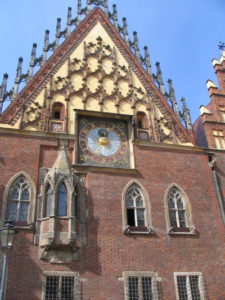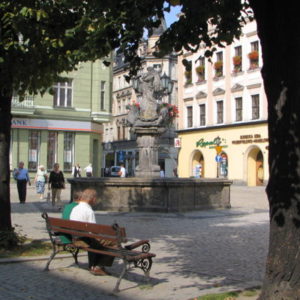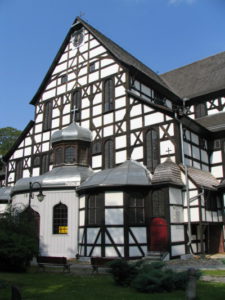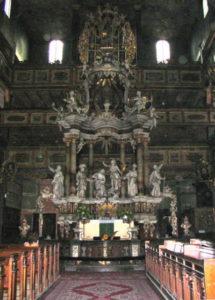As Poland increasingly becomes a travel destination, chances are stops will include the capital, Warsaw plus the ancient city of Krakow, and perhaps Wroclaw (formerly Breslau).
MOST UNIQUE JOURNEY FROM FRANCE TO CHINA
THE MIXTURE OF BAD, AND UGLY . . .
After Warsaw and Krachow, Wroclaw may not be on many itineraries. Given that this historic city is filled with good restaurants, 4+ hotels, music festivals, but not to be forgotten, also, the cruelty of the Jewish population in WW II. Ironically there are in magnificent churches, a buzzing main square and grand architecture, it is worthy of a day on your itinerary .
SCHLOCK ABOUNDS
 I should have anticipated when, Renato, my guide, tells me that we’ll be visiting, the Skull Chapel, that this would be a bit of touristy ‘schlock’. It is.
I should have anticipated when, Renato, my guide, tells me that we’ll be visiting, the Skull Chapel, that this would be a bit of touristy ‘schlock’. It is.
Located in a small Polish village, Kudowa Zdroj, the touristy element is strikingly obvious.
A HINT IF WHAT WAS TO COME
A small shop features some of the worst souvenirs I’ve seen in years and if it could shout, it would shriek,’ tourist trap’.
AND THEN THE REASON I’M HERE
Since the chapel is small, I wait with Renata, outside in the sunshine for the dozen visitors to exit. There is nothing of interest to occupy us since there isn’t even a small green area for us to walk through.We sit.
A small man, with a big grin greets us as he takes our zlotys. When we enter the chapel and even though there are only 10 others, we are crammed, as each avoids getting too close to the walls.
THIS SMALL MUSEUM SUCKS
From floor to ceiling there are bones . . . skulls and tibias from victims of the Silesian wars and various other encounters.
Built by the local priest in 1776, it was thought this would be a fine memorial to the victims. Perhaps it was but I find it shocking and ugly. And as a bonus, Mr. Big Grin, gives us a special thrill. He opens a trap cellar door displaying more grayish, dusty, disturbing skulls and bones.
Luckily, he had opened the front entrance for us to get a better look. I dash out into the fresh air and sun, glad to be away from this small, unnecessary chapel but obviously popular, but cruesome destination.
GET ME OUTTA HERE
However, the macabre element must have appeal to others less queasy since there’s another line-up waiting to enter.
SWIDNICA, POLAND, SMALL BUT EXQUISITE AND FILLED WITH HISTORY
 My guide, Renata and I reach the historic, over 700 year old town of Swidnica. . As with most Polish cities and towns, there’s a main square where we have a typical but far too large Polish lunch of steak, potatoes and pierogis.
My guide, Renata and I reach the historic, over 700 year old town of Swidnica. . As with most Polish cities and towns, there’s a main square where we have a typical but far too large Polish lunch of steak, potatoes and pierogis.
Our visit is to see the Church of Peace, about a 10 minute walk from the square and considered the outskirts of town. We pass small shops and modest houses. This is not a city of great wealth and with a population of only 20,000, it has a great amount of parks, about 11, which makes Swidnica very picturesque.
AN UNEXPECTED ARCHITECTURAL GEM
An inconsequential stucco archway next to a gift shop leads us to a walkway in a tree- filled garden where the sun is streaming through the leaves making the most unusual patterns on the grounds. I stop at the sight of the white stucco building crisscrossed with black wood. I immediately think it’s a Tudor look- alike. Its architecture seems so out of place since it’s located in a district of ordinary low rise, Soviet-style square, unembellished buildings.
Renata, urges me on since we have a full schedule before darkness descends and we have to drive back to Wroclaw (Warsaw) on the narrow road. The building appears small, but once inside the true size is a surprise.
CHURCH OF PEACE
 This basilica has a most unusual history and is somewhat of a miracle. After the Thirty Years’ War, the German Emperor Ferdinand III was forced by the Swedes to allow them to erect a Protestant church. So in the mid 1600s the site was marked out by 200 steps each direction, a true square. The church was allowed to be 100 steps long and 50 steps in width. There’s no clue of who measured this or how big his feet were but it is a sizeable church which could accommodate 7500 people and seats 2000. If one believes in miracles then construction is just that. The only materials that was approved and allowed for the Church of Peace were wood, sand, clay and straw, absolutely no nails or metal supports. There were also a few conditions, one being that there could not be a belfry and that it had to be built within one year.
This basilica has a most unusual history and is somewhat of a miracle. After the Thirty Years’ War, the German Emperor Ferdinand III was forced by the Swedes to allow them to erect a Protestant church. So in the mid 1600s the site was marked out by 200 steps each direction, a true square. The church was allowed to be 100 steps long and 50 steps in width. There’s no clue of who measured this or how big his feet were but it is a sizeable church which could accommodate 7500 people and seats 2000. If one believes in miracles then construction is just that. The only materials that was approved and allowed for the Church of Peace were wood, sand, clay and straw, absolutely no nails or metal supports. There were also a few conditions, one being that there could not be a belfry and that it had to be built within one year.
The corner stone was laid on August 23, 1656. Much thought about the design is obvious. The plan is a Greek cross and has the main part of the three aisles cross the three aisle transept in the center of the church. Wooden columns were use to act as retaining elements
NOT A NAIL IN SIGHT
Expected by the Catholic donators of the land that this all-wood, timber frame building would never last very long through the difficult winters, it is now a great curiosity and a UNESCO listed world heritage site. However, I look around, and other than Renata, there is a lone man who is deep into reading a travel guide, never looking up to see the rich interiors with wondrous painted ornate hand made wood carvings which have been well looked after but with the assistance of outside finances. Because there are so few Evangelicals, about 120, maintenance was too costly for them to absorb the funding. Enter the Church Foundation Gustav Adolf, Federal Ministry for Search and Technology in Bonn, Federal Foundation of Environment Protection in Osnabruck and Foundation of Polish German Cooperation in Warsaw, each donated enough money to allow restoration. Concern about the framework, which was in a catastrophic state, was a priority. It would have been a colossal disgrace if this building hadn’t been saved.
HAND CRAFTED LIKE NONE OTHER
 The beauty of the interior and its artistic artifacts could easily be interpreted and worthy of being called a museum. And remembering that all the bas relief and panel and sculptures are all wood, it was a triumph to complete these perfectly executed figures and the extravagant pulpit which stands in the north eastern corner. Above the entrance door there is an effigy of Jesus the good Shepherd. Looking at the organ, built in 1666-1669, the stunning baroque instrument is supported by athletes, and figures of angles and the ceiling is a work of art based on the theme of the last book of Holy Write – Revelations of St. John. If one took the time, they would discover 78 texts of Biblical verses and allegorical scenes in this richly decorated basilica.
The beauty of the interior and its artistic artifacts could easily be interpreted and worthy of being called a museum. And remembering that all the bas relief and panel and sculptures are all wood, it was a triumph to complete these perfectly executed figures and the extravagant pulpit which stands in the north eastern corner. Above the entrance door there is an effigy of Jesus the good Shepherd. Looking at the organ, built in 1666-1669, the stunning baroque instrument is supported by athletes, and figures of angles and the ceiling is a work of art based on the theme of the last book of Holy Write – Revelations of St. John. If one took the time, they would discover 78 texts of Biblical verses and allegorical scenes in this richly decorated basilica.
Our drive back to Wroclaw is long but pleasant as we applaud the magnificence of the Church of Peace. A day of complete pleasure.

